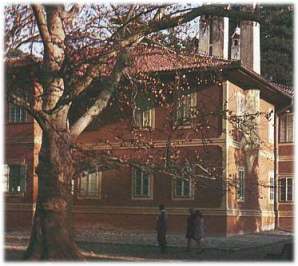 After building the residence for his wife and children in the town of Belgrade, Prince
Miloš Obrenović had this one built for himself in
1831 - 1834 in Topčider, a wooded area outside the town. After the grounds had been laid
out, the residence was built by the craftsmen Janja Mihailović and Nikola Đorđević, the
works being supervised by architect Hadži Nikola Živković, who was responsible for almost
all Prince Miloš's building projects. Like Princess Ljubica's Residence,
the architecture shows signs of the transition from Balkan to central European styles.
The rich decoration of the interior ceilings, walls andniches has been partially preserved.
During his first reign (1817 - 1839), Miloš stayed here only occasionally but when he ruled
for a second time (1859 - 1860) this was his premanent home. He died here on 14 September 1860.
At one time, the Residence housed the Museum of the Princes Miloš and Mihailo Obrenović and
then the Museum of Forestry and Hunting, which was founded in 1929. The Museum of the First
Serbian Uprising was opened here in 1954 during the celebrations to mark the 150th anniversary
of the uprising. The theme of its exhibits was the whole period of liberation struggle
against the Turks, from 1804 to the Sultan's second Hatisherif in 1839, and they served as
basis for the formation in 1963 of the Historical Museum of Serbia.
After building the residence for his wife and children in the town of Belgrade, Prince
Miloš Obrenović had this one built for himself in
1831 - 1834 in Topčider, a wooded area outside the town. After the grounds had been laid
out, the residence was built by the craftsmen Janja Mihailović and Nikola Đorđević, the
works being supervised by architect Hadži Nikola Živković, who was responsible for almost
all Prince Miloš's building projects. Like Princess Ljubica's Residence,
the architecture shows signs of the transition from Balkan to central European styles.
The rich decoration of the interior ceilings, walls andniches has been partially preserved.
During his first reign (1817 - 1839), Miloš stayed here only occasionally but when he ruled
for a second time (1859 - 1860) this was his premanent home. He died here on 14 September 1860.
At one time, the Residence housed the Museum of the Princes Miloš and Mihailo Obrenović and
then the Museum of Forestry and Hunting, which was founded in 1929. The Museum of the First
Serbian Uprising was opened here in 1954 during the celebrations to mark the 150th anniversary
of the uprising. The theme of its exhibits was the whole period of liberation struggle
against the Turks, from 1804 to the Sultan's second Hatisherif in 1839, and they served as
basis for the formation in 1963 of the Historical Museum of Serbia.
After the building has been overhauled and restored, it will again be the home of the Museum
of the First Serbian Uprising.


Albania Palace Building | The Bajrakli Mosque | Belgrade Palace Building | Belgrade Railway Station | Captain Miša's Building | Cvijeta Zuzorić Art Pavilion | Karađorđeva Street | Knez Mihailova Street | Princess Ljubica's Residence | Millenary Monunemt on Gardoš Hill | Price Miloš's Residence | The National Theatre | Nemanjina Street | Nikola Pašic Square | Republic Square | Skadarlija | Slavija Square | Student Square | The Trade Union Hall | Terazije Square | The '?' Cafe Restaurant | Article about the architecture and building in Belgrade |